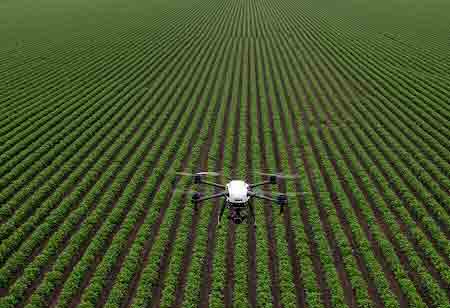Thank you for Subscribing to Agri Business Review Weekly Brief
Transforming Canadian Agriculture with Advanced Drone Technology

By
Agri Business Review | Thursday, April 24, 2025
Stay ahead of the industry with exclusive feature stories on the top companies, expert insights and the latest news delivered straight to your inbox. Subscribe today.
Canada’s agricultural sector is undergoing a significant transformation, propelled by integrating advanced technologies designed to enhance efficiency, sustainability, and productivity. At the forefront of this evolution is the rapidly expanding field of agricultural drone services. Once considered a novelty, unmanned aerial vehicles (UAVs)—equipped with sophisticated sensors and analytical tools—are now indispensable assets, providing Canadian farmers with unparalleled insights and operational capabilities.
Technological Foundations of Agricultural Drone Services
The effectiveness of agricultural drone services is rooted in the sophisticated hardware and software systems that enable high-resolution aerial data acquisition. In Canada, multi-rotor (rotary wing) drones are widely used due to their ability to hover and adaptability to diverse terrain conditions. However, fixed-wing drones are gaining popularity for their efficiency in surveying large agricultural areas.
Multispectral sensors are central to many drone-based services, capturing data across several light bands, including near-infrared (NIR). This capability allows for the generation of key vegetation indices such as the Normalized Difference Vegetation Index (NDVI), which is essential for assessing plant vigour, photosynthetic activity, and overall crop health. These insights reveal field-level variability that is not always visible to the human eye. Though less prevalent, hyperspectral sensors provide even greater spectral resolution for specialized diagnostic or research purposes.
Thermal sensors further augment drone capabilities by detecting temperature variations across fields. These data are instrumental in identifying crop water stress, evaluating irrigation performance, monitoring soil moisture levels, and assessing infrastructure such as greenhouses for heat loss. LiDAR (Light Detection and Ranging) sensors are employed to generate high-precision Digital Elevation Models (DEMs), which are critical for understanding topography, planning drainage systems, and optimizing water management strategies.
A Spectrum of Services
Among the most established services is crop monitoring and health assessment, where drones are deployed throughout the growing season to capture high-resolution imagery. This imagery is processed into NDVI or relative plant health maps, enabling early detection of nutrient deficiencies, disease, pest infestations, and environmental stress. Specialized assessments—such as winter wheat survival analysis or post-frost damage evaluations—provide growers with quantifiable data to guide replanting or management decisions. Additionally, stand count analysis supports evaluations of planter performance and emergence uniformity.
Drone-derived data is also critical in precision agriculture, particularly in support of variable rate application (VRA). By delineating management zones using NDVI or other vegetative indices, service providers help generate prescription maps for precise applications of fertilizer, nutrients, or fungicides. This approach enhances input efficiency and can reduce overall application volumes. Furthermore, field mapping and soil analysis services are advancing beyond boundary mapping to include high-accuracy topographic maps and digital elevation models (DEMs), using RGB and LiDAR data. These tools support erosion control, irrigation planning, and land use assessments. Some providers integrate soil sensor data to refine nutrient management strategies further.
The sector is also evolving with a range of specialized applications. Drone-based applications of greenhouse shading materials and thermal inspections to identify energy inefficiencies are becoming more common. While drone spraying of pesticides remains regulated, drones are increasingly used for broadcasting cover crops and applying granular fertilizers, especially in difficult terrain or limited-access fields. Environmental monitoring is another growing use case, with drones supporting the assessment of buffer zones, riparian areas, and conservation land for stewardship reporting and compliance.
Market Growth and Integration of Drone Services
The adoption of agricultural drone services is steadily expanding across all sizes and operational models of Canadian farms. This growth is driven by drones' clear benefits in optimizing input use, enhancing resource management, addressing labour constraints, and advancing sustainability objectives. Market projections suggest that the Canadian agricultural drone sector could approach a valuation of US$1 billion by 2030, reflecting a compound annual growth rate (CAGR) of over 25 per cent beginning in 2025. Government initiatives, such as the Canadian Agricultural Partnership, further support this trajectory by encouraging the uptake of precision agriculture technologies.
Notably, the data generated by drones gains its most significant value when integrated into comprehensive digital farming systems. Service providers typically supply data in standardized formats compatible with widely used Farm Management Software (FMS) platforms and precision agriculture equipment controllers. This interoperability enables drone-derived insights to inform and enhance farming operations, fostering a synergistic effect within the farm's broader digital ecosystem.
Unlocking the True Value of Agricultural Drone Services
The actual value of agricultural drone services extends well beyond image capture. The core proposition lies in transforming raw aerial imagery into actionable insights that drive precision agriculture. Service providers leverage advanced processing software to compile hundreds—or even thousands—of images into detailed ortho mosaics (georeferenced maps), generate Digital Elevation Models (DEMs), and calculate a range of vegetation indices.
Integrating Artificial Intelligence (AI) and machine learning into analytics workflows rapidly enhances the precision and utility of drone-derived data. These technologies facilitate advanced object detection, such as identifying specific weed species, improving stand count accuracy, assisting in early disease detection, and contributing to yield prediction by analyzing temporal patterns in crop health.
The final deliverables for farmers typically include a suite of interpreted maps and data layers, accessible through cloud-based platforms or directly compatible with Farm Management Software (FMS). These outputs enable informed, data-driven decisions—pinpointing where to conduct further scouting, optimizing fertilizer and irrigation applications, and identifying areas most affected by weather events or other stressors.
Agricultural drone services in Canada have become a key pillar of data-driven farming. Enabled by cutting-edge technology and supported by a robust regulatory infrastructure, these services empower farmers to monitor crop health, manage inputs with precision, and make proactive decisions throughout the growing season. As innovations continue to emerge and integrate with broader digital agriculture ecosystems, drone services are poised to play an increasingly central role in enhancing Canadian agriculture's efficiency, productivity, and sustainability.





